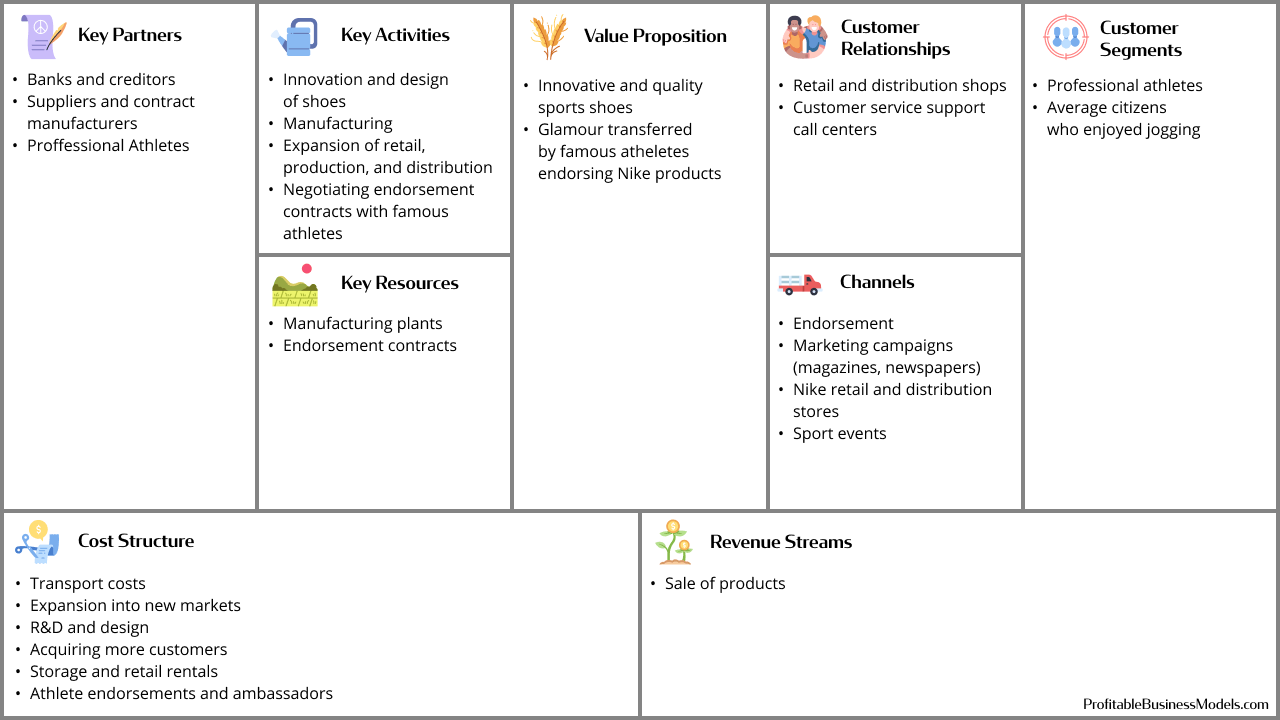Introduction
“Reebok has been dedicated to making athletes faster.” Reebok has created a product for the sheer purpose to better the health and improve the athletic ability of consumers. The business plan of Rebook involves business model, SWOT Analysis, Revenue Model and many more.
The brand was formed in the United Kingdom in 1958 as a subsidiary of J.W. Foster and Sons, a sports goods firm founded in Bolton, Lancashire, in 1895. The firm’s roots were symbolized by the use of the British flag in its emblem from 1958 until 1986. With regional offices in Amsterdam, Montreal, Hong Kong, and Mexico City, the company’s worldwide headquarters are located in Boston, Massachusetts in the United States.
Reebok has identified the fitness sector as a “significant opportunity” and it hopes to “own this space” around the world.
Revenue Model
Reebok has an estimated web sales of $500M-$1B. In the Indian market, it has a share of 47% in the sports footwear and apparel category. Reebok has now expanded in Pakistan and Sri Lanka as well.
Reebok was acquired by Adidas for $3.78 billion and this was a game-changing moment to help Adidas dethrone Nike from its position as no. 1. Adidas’s global presence and strong brand recognition have helped Reebok target newer markets more efficiently.
In the year 2017, it obtained the status of the most valuable brand and has acquired a very high brand value of $1.2 billion. The brand has been doing well in the market and speaks of elegance and style in sports.
Business Model Canvas

Competitors of Reebok
SWOT Analysis
Strengths
The following are the strengths of Reebok:
- Segment: Reebok has a very clear segment to which it offers its products. On a broad level, Reebok sells shoes and other sports accessories to sportspersons or exercise enthusiasts. However, within their product range, they have specific product ranges for specific sports needs which target niche sub-segments within each category.
- Feature-rich products: Reebok products are known for their features and styling. Each type of footwear manufactured by Reebok has features that suit their need or benefit and this has always been a strong selling point for the brand. For example, their athletic footwear Crossfit has been designed to provide the best running experience to athletes whether they are first timers or seasoned professionals.
- Multi-channel distribution strategy: Reebok sells their products through a range of distribution channels. Right from their own independent stores to popular retailers as well as online shopping portals like Amazon or their own website Reebok has the multi-channel presence. This makes it convenient for the customer to shop from
- High customer engagement: Reebok has used social media to reach out to more than 35 million customers in a boost to improve customer engagement. For example, Reebok identified a huge opportunity in combat training shoes and they have used Facebook and Instagram to understand the needs of their target group or create forums where they can discuss their concerns or get suggestions from experts. The same strategy has also been mirrored in other niche categories.
- Celebrity Endorsements: Reebok is endorsed by the best sportspersons in the world. Some of their endorsers have been Floyd Mayweather Jr, Shawn Kemp or Allen Iverson. Recently Reebok has also been listing musicians and rappers as their endorsers. Some popular names in this category are Jay Z, Alicia Keys, Swiss Beats or TYGA.
- The “cool “ Image: Reebok was quick to realise that the millennials as well as Gen Y were also looking for the cool quotient in their sportswear. In order to incorporate this Reebok roped in Chris Kwiatkowski, a graphic designer from their Sports Licensed Division, and design leaders Peter Quagge and Chuck Gates into mainstream decision making. The move has not just made their products cooler but also improved the in-store ambience.
- Loyal Female base – In 1979, Reebok introduced the Aztec princess which happened to be their stepping stone to the US market. When no one was thinking about Women’s sports shoes, Reebok became the first brand to release Women athletic shoes. Since then Reebok has never let their targeted women audience down, creating a loyal female base.
- Segmentation – Reebok manufactured products for specific sports usage and categorised it to specific segments. This creates the brand image of creating products that cater to specific audiences – meeting demands.
- Price range – They aim to sell products at an average price, making their goods accessible to the middle-class. This gave the customers an option to utilise high-quality products. Other competitors don’t reach this market as their starting price of products belongs to the luxury category.
- Strong International Sponsorship – UFC and Spartan Race officially have a sponsorship deal in Apparel and Footwear with Reebok. The company has a stronghold on Hockey, Football, and Baseball sponsorships, globally. Moreover, they sponsored influential players in the NFL, UFC and NBA as well.
Weaknesses in the SWOT analysis of Reebok
Some of the key weaknesses of Reebok are:
- Excessive commercialisation: The sportswear segment is so competitive that brands are trying their best to commercialise their interests. The results of this is that products like Reebok which were once considered to be premium are now categorized alongside local or regional players who cater to the mass market. This dilutes the brand image.
- Poor awareness: Though Reebok has a lot of products which cater to specific sporting needs of customers the company has been hugely unsuccessful in educating customers with the result that the brand has today largely become associated with sneakers.
- Poor Marketing Strategy – Reebok’s shortcoming in marketing is its main weakness. While other athletic shoe manufacturers are promoting their product lines, Reebok is not and remains out of constant reach with their customers.
- Negative PR – Any negative controversy affects the Brand image. In 2017, CrossFit said Reebok was dishonest and fraudulent, claiming $4.8 million in breach of contract. Another major controversy was an ad campaign in Germany asking gym-goers to cheat on their girlfriend instead of exercising. These kinds of controversies create a strained relationship between the brand and the customer – creating a negative brand value.
Opportunities in the SWOT analysis of Reebok
Some of the opportunities include:
- Looking at new markets: Reebok which was once the leader in sportswear has lost out to arch-rival Nike. But the brand has huge plans to revamp itself by moving into new categories such as ethnic designs, women’s speciality sportswear and kids shoes.
- Niche areas: In fitness today there are various niche categories such as combat shoes, dancing shoes, aerobics shoes or training shoes. Though Reebok has the presence in most of these categories customers need to be educated more on why such specific needs have to meet. This will result in the growth of such sectors.
- Social Media Marketing – Social Media is now a prime location for Marketing, After Sales service, Customer services, Customer communication, and many more. To be in the spotlight or on the top of the customer’s mind it needs to be active on Social Media. Their lack of a strong presence and strategy in the digital sphere of marketing is a setback.
- Heightened Interest in fitness – Due to Covid-19, the movement around the world stopped due to quarantine. This created a lethargic environment. However, the fitness geeks and gradually the whole of society began looking out for home work-out options.
Threats in the SWOT analysis of Reebok
Some of the threats include:
- Competition: The main competitors of Reebok are Nike, Adidas, Converse, New Balance and Puma.
- Steals: Designer sportswear brands like Nike and Reebok also face serious threats from cheap imitation which are sold at throwaway prices. Customers who are on the lookout for just the styling and not very concerned about features often prefer to purchase these cheap imitations.
- Over-reliance on Footwear sales – Footwear is Reebok’s largest division and therefore the company depends fairly heavily on the footwear market. Reebok had also to bear in mind that the marketplace for costlier footwear was slowing. This might ultimately force costs down, ought to this trend will continue for a major amount of time. The corporation was so dependent on footwear that it risked losses, whereas other competitors resembling Nike will fall back on their attire division.
- Unpredictable Fads – It implies that economic processes are unpredictable. E.g., client tastes for garments change frequently. Thus, the style business suffers an excellent uncertainty. The style may live for a few days or even years. The fads are unpredictable and pose a threat.
- Fluctuation of International currency – A depreciation of the local currency increases the cost of imports of goods, which can reduce the volume of imports Domestic companies will benefit from increased sales, profits and employment.
Conclusion
Reebok has also worked to make its products available for averaged income households, thus expanding their reach. Reebok uses multiple channels of digital marketing such as SEO, Emailing and Content Marketing to promote and educate its clients about newer products.




